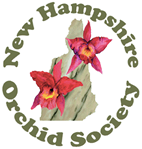 |
NH Native Orchid Project
All of us see pink lady slipper orchids (Cypripedium acaule) each spring. They appear to be, and are considered "common". New Hampshire has over 50 native orchid species... and many of them are very rare - either threatened or endangered. Those most rare species are documented by counting plants and sites, monitored by the NH Heritage Program (NH Division of Forests and Lands), in cooperation with US Fish & Wildlife, and the New England Wildflower Society.
In working with these agencies over the past several years, it has become clear that there is a group within the 50 or so species which are considered "plentiful", "common" or not specifically threatened. So, with limited resources, they are not monitored by any group. That's where we fit in. NHOS will begin not simply observing native orchids, but actually documenting sites and numbers of the species which are NOT currently monitored, like Cypripedium acaule, the Goodyeras, and some of the Platantheras (fringed orchids) to name a few. We'll work together, creating a secure database of sites and numbers from year to year, and begin the process of documenting numbers.
There are several good reasons for our Society to take on this project. With the development happening in New England, many people suspect that those orchids previously thought of as "common" may be declining. Some of them may deserve protection status, but there's no data to substantiate that at the current time. Involving our broad membership is a great use of peoplepower... as they walk and hike on their own and public lands. Of course, when we stumble across one of the threatened and endangered ones, we'll celebrate first, then pass the information on to the other monitoring agencies.
I encourage all of our members to send me emails throughout the spring, summer, and fall listing the numbers of wild orchids they see in an area. List the numbers of plants (exact count if less than 50, estimate if more), the genus and species, the percentage of plants in bloom, the percentage with seed pods. Indicate the date you saw them. Take photos! If you have a GPS location, great. If not, that's fine. Indicate public or private property and who owns it if known (we will respect privacy... this will be used only to assign location numbers - exact locations not published except perhaps counts by town/county at some future point).
Update: October, 2011 So far we have documented sites with Cypripedium acaule, Calopogon tuberosus, Goodyera pubescens, Goodyera tessellata, Isotria medioloides, Platanthera blephariglottis, Platanthera grandiflora, Platanthera hookeri, Platanthera lacera, Platanthera obtusata, Platanthera psycodes, Pogonia ophioglossoides, Spiranthes ochraleuca. Fall and winter is actually a very good time to look for the Goodyeras, which are evergreen rosettes, often found in piney woods habitat, and near pink lady slippers. Keep your eyes open for these evergreen treasures!
Let's see what we can accomplish... together!
Jean Stefanik, Education & Conservation
Email Jean Stefanik

